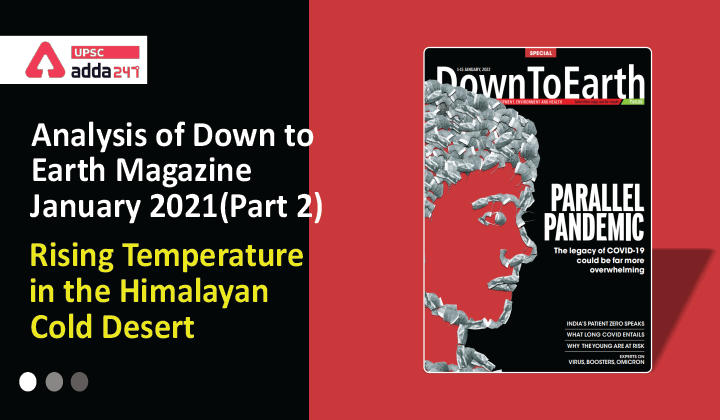Table of Contents
Analysis of Down to Earth Magazine: ”Rising Temperature in the Himalayan Cold Desert”
Relevance
”GS 3: Environmental Pollution & Degradation, Conservation, Water Resources”
Context
- Changing nature of glaciers and glacial lakes make the Himalayas one of the most climate-vulnerable regions on the planet.
- Sudden snowfall in January, following a warm December in Himachal Pradesh, was unexpected and has left all in shock.
Background
- Even 15 years ago, November would bring with it the season’s first snowfall in the Valley and by March, there would be a healthy snow cover of 1.5 m. Last winter season (November 2020-April 2021), the snowfall started as late as March and by April, the snow cover was only 0.5 m, which melted almost as soon as it fell.
- The data shows the area under all the four major river basins in the state—Ravi, Sutlej, Chenab and Beas—have shrunk in 2020- 21.
- The snow cover in the Chenab basin has shrunk by 638.2 sq km between 2019-20 and 2020-21. The Beas basin has reduced by about 19 per cent.
- The Ravi basin has seen an overall reduction of 23 per cent in the total area under snow cover, while the snow cover in the Sutlej basin has shrunk by 2,777 sq km (23 per cent) to 9,045.51 sq km.
Why are these changes problematic?
- The temperatures are consistently rising and the warm weather now lingers on much longer. Precipitation in the form of rain and snowfall is also on the decline.
- The warm winters and unexpected snowfall are symptomatic of a bigger problem: the changing precipitation in the entire cold desert region. The changing precipitation is impacting farming, which is already difficult in the harsh climatic conditions of Spiti. The 110 families in Komik grow jowar, vegetables and black peas for personal consumption, and green peas for the market.
- The impact of the changing temperature can be seen in the glaciers. The Pensilungpa glacier in the Zanskar Valley Ladakh’s Kargil district had shrunk by 36 per cent between 1962 and 2012, says a study released on August 6, 2021, by the Wadia Institute of Himalayan Geology, Dehradun, under the Union government’s Department of Science & Technology.
- The study found that increasing temperature and low winter precipitation were responsible for the shrinking of the glacier between 2015 and 2019 at a rate of 6.7 m per annum.
- It has also had an impact on the region’s biodiversity, especially around its lakes and wetlands. These lakes are mostly fed by the springs and streams flowing down from the melting snow in the mountains and glaciers. Bird species like the magpie, sparrows and red-billed chough have decreased in number.
- The area under snow cover in Himachal Pradesh has declined by 18.5 per cent, according to a recent report published by the Centre on Climate Change of the Himachal Pradesh Council for Science Technology and Environment and the Space Applications Centre, Ahmedabad.

- It reveals a decreasing trend in all the five major river basins in the state. The ice-covered area of the Chenab basin shrank from 7,154.11 sq km in 2019-20 to 6,515.91 sq km in 2020-21. Similarly, Beas basin reduced from 2,457.68 to 2,002.03 sq km, Ravi basin from 2108.13 sq km to 1619.82 sq km and Sutlej from 11,823.1 sq km to 9,045 sq km.
- Overall, the snow-covered area reduced from 23,542 sq km to 19,183 sq km in the state.
- The maximum reduction in snow cover has occurred in the Sutlej basin, which covers 45 per cent of the total geographical area of the state.
- The Sutlej basin catchment is the largest and so the changes visible here are more significant.
Factors that have worked together to create this crisis
- There is no doubt that global warming is contributing to these changes. But the local conditions also play a role in reducing or increasing its impact.
- Construction of dams has been rampant in the Sutlej valley; the practice began post-independence and continues today. A dam once built stores a huge amount of water. Debris from many villages and trees also collect inside the dam. The stagnant water receives heat from the sun to form mist in the surrounding area by evaporation and simultaneously generates methane gas.
- In the 1930s and 1940s, Shikari Devi and Kamrunag hills used to have snow-covered peaks for about six months, now the snow remains for only two months. Fog is prevalent and has also made the area warmer. Due to this, the snow has started melting quickly.
- Apart from this, the local crop patterns have been affected. Post the 1990s, the Sutlej became a site for run-of-the-river hydroelectric projects using extensive underground tunneling. This involves the massive use of explosives to blast through mountains. Unplanned tourism and other development activities also shifted local weather patterns.



 TSPSC Group 1 Question Paper 2024, Downl...
TSPSC Group 1 Question Paper 2024, Downl...
 TSPSC Group 1 Answer key 2024 Out, Downl...
TSPSC Group 1 Answer key 2024 Out, Downl...
 UPSC Prelims 2024 Question Paper, Downlo...
UPSC Prelims 2024 Question Paper, Downlo...
